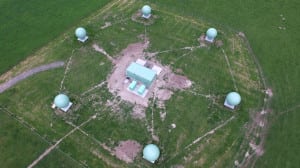Latest News
[Via Satellite 12-03-2015] Plans to boost to the satellite Search and Rescue (SAR) system in New Zealand and Australia are well underway as a New Zealand-based, $7.2 million satellite ground station reached completion in November. As part of a joint initiative by Maritime New Zealand and the Australian Maritime Safety Authority, the McMurdo Group completed installation of a six-antenna next-generation Medium-Earth Orbit Search and Rescue (MEOSAR) satellite ground station system built near Tuapo in New Zealand. The new system aims to replace the aging Cospas-Sarsat Low-altitude Earth Orbit (LEO) international satellite distress alerting system.
The U.S., France, Canada and former USSR established the original system —known as the LEOSAR system in conjunction with the associated ground receiving stations — in 1979, according to the National Oceanic and Atmospheric Association (NOAA). It operates at 406 MHz and makes use of LEOSAR and Geostationary (GEO) satellites to calculate the location of distress beacons by measuring the Doppler effect on the received beacon signals.
To remedy gaps and delays in beacon activation and alert message generation that occur as a result of satellite orbit patterns, the LEOSAR satellites are being phased out over the next four years in favor of the MEOSAR system. This will also help to augment the sometimes-spotty coverage experienced by New Zealand and Australia due to the limited number of satellites in the system that monitor the Southern Pacific.
“Because of New Zealand’s distance from the equator, the GEO satellites are low on the horizon, which can limit their line-of-sight visibility, particularly in mountainous terrains,” Mike Hill, manager of Rescue Coordination Center New Zealand (RCCNZ) and safety services for Maritime New Zealand, told Via Satellite. “That makes LEO satellites important, but these are limited in number and not always over New Zealand, so there can be delays between a beacon activation and its detection by a LEO satellite.”
As with the current LEOSAR system, when a beacon is activated, the signal will be detected by all MEOSAR satellites in line-of-sight. The more satellites that detect the beacon, the greater the accuracy of positioning information.
According to Hill, the chances of a satellite being in line of sight of beacons will greatly increase as the number of MEOSAR satellites orbiting the Earth continues to rise. There are currently at least 18 MEOSAR satellites operating, compared to five LEOSAR satellites, a number that will jump to over 50 MEOSAR satellites in orbit over the next 10 years.
“As with the LEOSAR system, beacon signals will pass through the MEOSAR satellites to the two ground stations, be processed through the Canberra mission control center, and relayed to the Rescue Coordination Center New Zealand, thus triggering SAR operations,” Hill said, noting that the RCCNZ responds to an estimated 550 beacon alerts each year. “Tests from the new site have already shown detection times will decrease, with test activations picked up every two or three minutes.”
The new ground station, along with a similar receiving station in Western Australia that began construction in 2014 and will be commissioned for use in next year, according to the Australian Maritime Safety Authority, are essential to allow data to be collected from the MEOSAR satellites orbiting over the New Zealand SAR region.
“Without this site, and the site in Western Australia, there would be a significant gap in global SAR satellite coverage in the Southern Hemisphere,” Hill noted.
Maritime New Zealand will now enter a period of testing for the site, after which Cospas-Sarsat will consider data from the ground station to ensure it meets appropriate standards and approve it as part of the global network. While Cospas-Sarsat will not introduce the MEOSAR system for global search and rescue until 2017, the New Zealand site is likely to be providing information for use in search and rescue operations in the New Zealand and Australia regions beginning in mid-2016.
Get the latest Via Satellite news!
Subscribe Now